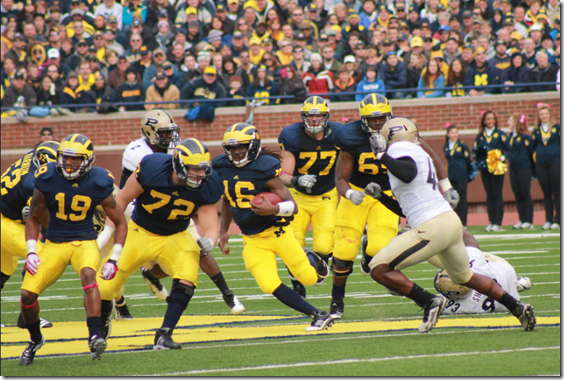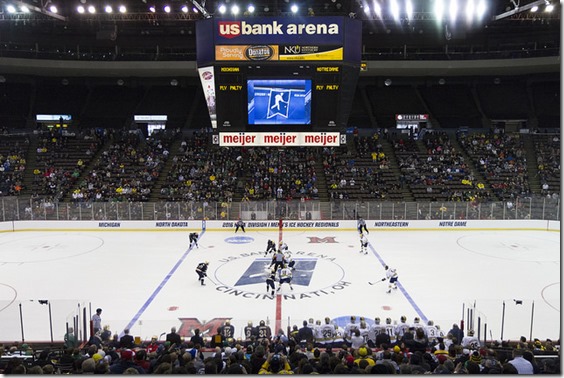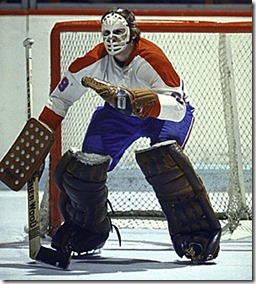i am completely serious about this
Can you name all the Michigan players in this photo from the last Purdue-Michigan game in Ann Arbor? [photo: a much younger Eric Upchurch]
Since going to 14 teams the Big Ten schedule has been a mess. Some teams rarely face each other, other teams face each other twice a season. The divisions are historically and presently uneven. The last two years in a row this resulted in a Big Ten “champion” that had a demonstrably worse season than at least two other Big Ten teams. Congrats Penn State and Michigan State, but I think we can do better. In fact I have an idea how.
I’ll get into the details below but the idea isn’t for everyone to have to memorize the details. The simplest description is every year you play three locked-in rivalry games, three games of your choosing, and three games against schools near you in the standings. Your biggest rivalry is played at the end of the season, and its result (half) carries over to next season.
On FiveThirtyEight’s Solution: Nate Silver’s proposal and mine share a few concepts: locked in rivalries early in the year, a mini-playoff at the end of the year, and eradicating divisions (which is essential to any good schedule reform). But it has two big flaws I tried to avoid:
1) It puts The Game in September, which: no, or in Week 7, which again: no, and then you’re seeding with less information.
2) Teams at the top will rarely face those at the bottom. I don’t like that because it cuts down on variety and could easily lead to things like long droughts between Michigan-Purdue tilts which are one of the things we’re trying to fix. Also it’s not good for the long term health of the conference since it would redistribute more losses from the bottom of the conference to the middle and middle-high. In effect it would result in fewer and lower ranked teams at the top, and fewer bowl-eligible teams from the conference. A few more competitive games is good, but 538’s proposal takes that to an extreme to the detriment of other important considerations.
Goals:
- Maintain the annual rivalries and maximize their importance, keeping the big rival games at the end of the season.
- Play 9 conference games.
- Split up rivalry games so every team has a compelling schedule every year to sell to season ticket holders.
- Produce a fair and least disputable conference champion by playing all or most of the relevant games during the season.
- Play as many competitive games between similarly ranked teams as possible.
- No rematches!
- See a variety of opponents over a 10-year period.
- Encourage Power 5 opponents in non-conference scheduling.
- Be relatively simple.
The system I came up with hit all of these benchmarks to varying degrees (#9 being measured in Kelvin). #5 conflicts with #7 so I left it up to the schools themselves to prioritize between them. As for #9 it’s actually complicated, but can have the appearance of simplicity.
The schedule has four components:
- Three locked-in games versus your annual rivals.
- Three games where the top teams draft their opponents.
- Three games where you play like competition, and the top four teams all play each other.
- A “Big Ten Showcase” invitational during conf championship week to play the best three games that weren’t played.
DIVISIONS
This is the easy part. The teams are all separated into four pods of three or four with rivals they ought to be playing every year.
| Grp | Big Two, Little Bro | East Coast Cable Subscribers | Intercollegiate Conference of Maladroit Representatives | Corn Corn Corn Corn Cheese Corn Corn Corn |
|---|---|---|---|---|
| A | Michigan | Rutgers | Illinois | Wisconsin |
| B | Ohio State | Maryland | Northwestern | Minnesota |
| C | Michigan State | Penn State | Indiana | Iowa |
| D | x | x | Purdue | Nebraska |
The division names are not important but the order is—if you want a clue as to why, look at the A-B and C-D matchups. Teams in your pod are the two or three teams you play every year. There are two ways to handle the three-team pods and I haven’t decided which I like better—either works about the same:
- Option 1: Lock in rivals. Each team gets an annual rival from the opposite division, e.g. Michigan-Maryland is played the week of OSU-MSU, PSU-OSU always comes when Michigan plays State, and Rutgers-Michigan State is played annually on the last week of the season for bragging rights and the Situation Trophy.
- Option 2: Rotate every 2 years. So after two seasons of the above, Michigan plays Rutgers on week 1, Ohio State plays Maryland, and the Land Grant Trophy becomes the end-of-year rivalry for MSU. Then after two years it becomes M-PSU, OSU-Rutgers, MSU-Maryland.
I sorta prefer Option 1 but Option 2 seems more feasible.
[HIT THE JUMP to see how I worked it all out]
An irregular series in which I fix all of a sport's problems.
[Patrick Barron]
10. Get rid of the penalty for flipping the puck out when you're in the defensive zone. This is exactly icing and should be treated like icing. The only competition for worst rule in sports is what happens when a football player fumbles and the ball goes out of the endzone.
9. Non-shootout wins are three points. The NHL is the only league in any sport in the world in which some games are worth more than others. This is so very dumb. College hockey uses a model where you get three for actually winning a hockey game, two for winning a shootout, and one for losing it. It is not an offense to God and math.
8. Widen the blue line. The blue line is a lovely demilitarized zone that is both offensive zone and defensive zone, so you can touch it and not be offsides. The puck can touch it and not exit the zone. Both of these things are good. No offsides whistle in the history of hockey has improved the experience of a neutral fan. Widening the blue line reduces these whistles.
7. In fact let's get rid of offsides whistles (almost) entirely. Instead of stopping the game, you can just continue playing hockey. An offsides team can't score. Game continues. Once team ceases being offsides you can go score.
6. And add passive offsides. If you can't tell already, I hate offsides in hockey. It boggles that if one guy is offsides then everybody is. If you're on a rush and one guy is a hair over the line, he and only he is offsides. Let him tag up; let everyone else continue playing. If an offsides player does anything other than try to get onside, I guess you can blow the whistle, you game-stopping ninny. But if offsides guy is headed for the blue line, let him get there.
5. Gradually introduce Olympic ice. Olympic ice is a lot of fun, but currently impractical for buildings not set up with a 100-foot-wide sheet already. The NHL should force new buildings to be Olympic-sized, leading to a transitional period where some rinks are small and some are wide and there are all kinds of home/away effects, kind of like baseball. Also there will be an increasing number of big rinks on which standing a guy up at the blue line is super difficult and skill is more important. College hockey already has a number of Olympic sheets, and the transition is both jarring and fun.
4. Just embiggen the goals already. Goalies won. Whether it's equipment size or improved technique, the fundamental truth about hockey over the last 20 years is that goalies win and we give up and to restore the proper tension of a hockey game we're going to admit they win and tweak the size of the goal.
Most protests about this are luddite or ludicrous. One common protest is that expanding the goal invalidates records going forward. It does not, at least any more than the various equipment advances have done so. Ken Dryden versus any modern NHL goalie is QED here:
Dryden's pads are not only smaller but infested with mice and 10-20 pounds heavier. Also he doesn't know about the butterfly. Goalies win, expand the net by the width of the posts, all CLANG events now are goals, add 2-3 per game, it's a good time.
This is important. The current state of hockey is too close to baseball, which is dumbly random, because the goalies can cover up big differences in team quality.
3. A team doesn't clear the offensive zone until the puck gets over the red line. Michigan actually experimented with this in an exhibition a few years back. It was deeply weird but it rewarded teams who could actually get ahold of the puck in the defensive zone and increased the number of shifts where one team was scrambling around defensively and it felt like the team with the puck absolutely had to score.
2. Force teams to change goalies on the fly once a period. This would be awesome.
1. Teams have the option of putting a guy on the ice without skates. Offsides does not apply to him. Goals he scores count double. The thing that hockey has lacked for far too long is a broomball player. What does the world's best broomball player look like? I don't know. You don't know. We've waited far too long to find out.




131